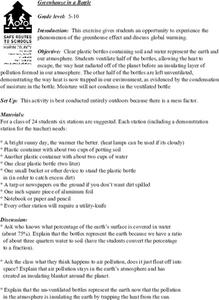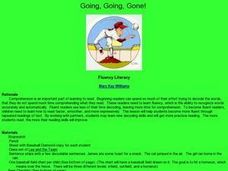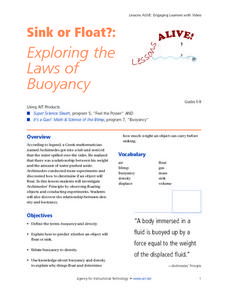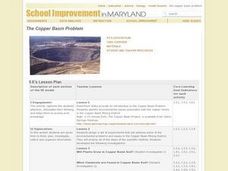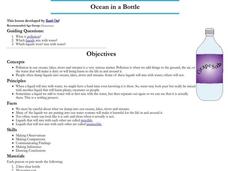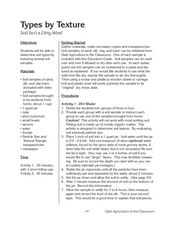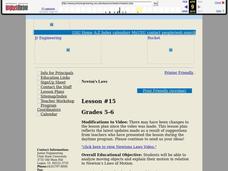Curated OER
Sound Vibrations
Young scholars play their own straw kazoos and understand that vibrations are responsible for the sounds we hear. Additionally, they learn that sound vibrations can travel through different mediums. Students experience vibrations ...
Curated OER
Greenhouse in a Bottle
Students create models of the greenhouse effect using recycled 2-liter bottles. They discuss how their models compares to the real greenhouse effect the earth experiences.
Curated OER
Lift and Launch Angle
Students engage in a hands-on experiment to determine how launch angles affect airflow around the wing of an aircraft. They view a series of photographs and read information describing the Wright Brothers' experiences. They complete a...
Curated OER
Going, Going, Gone!
Sixth graders use the scientific method to test variables of evaporation. In this evaporation lesson plan, 6th graders test a wet handprint on a paper towel and relate this experiment to weather conditions.
Curated OER
Sink or Float: Exploring the Laws of Buoyancy
Learners explore the relationship between density and buoyancy. After watching a video explaining buoyancy, students discuss displacement and floating. Learners have a raft building competition. Afterward, they conduct experiments to...
Curated OER
The Copper Basin Problem
Students view a video about how human actions impact the environment. They design a set of experiments to address some of the problems and issues raised by the video.
Curated OER
Comparing Solids, Liquids, and Gases
In this solids, liquids and gases worksheet, learners observe a teacher demonstration about gases and they experiment with liquids to show diffusion, shape and volume. They answer nine questions about the experiments related to solids,...
Curated OER
Recycling
Third graders observe the importance of recycling. In this environmental activity, 3rd graders will view experiments on water filtration, paper-making, and breathing pollutants, and will categorize recyclable materials.
Curated OER
Projectile Motion
Students determine the angle of launch that will give a projectile its greatest range. In this projectile motion instructional activity, students recognize that the motion of a projectile results from the combined horizontal and vertical...
Curated OER
Magnets
Students explore magnetism by observing a series of 8 magnet "tricks" performed by the instructor. In this magnets lesson plan, students predict which items will be attracted to a magnet and experiment to see if they predicted correctly....
Curated OER
Sound: What is Sound and how does it travel?
Students learn that vibration makes different types of sounds. In this sound lesson plan, students perform experiments to understand vibrations and high and low pitch sounds. Students learn that sound travels differently through...
Curated OER
Ocean in a Bottle
Students investigate pollution in water. In this pollution lesson, students participate in an experiment to simulate water pollution. Students observe how the water reacts to the "pollution."
Curated OER
Types by Texture: Soil Isn't a Dirty Word
Second graders experiment with different types of soil to find the texture. In this types of soil experiment, shake a jar of soil and water and record the settling of the soil. Students record again after 3-4 hours and note the level...
Curated OER
Super-Ball Physics
Students experiment with varied balls to determine the bounce factor in centimeters. For this physics lesson, students experiment to find the height a ball must be dropped from the have the highest bounce rate. Students graph the results...
Curated OER
Lightning!
Students use aluminum, a thumbtack, an eraser, and more to create static electricity. In this static electricity lesson plan, students use this experiment to simulate lightning.
Curated OER
Keeping Warm When it is Cold: How does a polar bear keep warm?
Students make a model of a polar bear and discuss why fur/skin color is important. They also perform a simple experiment using black and white socks to determine how color affects temperature.
Curated OER
Gravity Gets You Down
Students investigate the force of gravity and how it effects different objects that are put into acceleration when applied the experiment of free falling. They drop different objects that have a variety of masses and some that cause air...
Curated OER
Planting Seeds Around the World
First graders discuss the book The Lorax and research what living things need. In this environmental instructional activity, 1st graders investigate how humans affect the growth of plants. Students conduct an experiment with sunflowers.
Curated OER
Water and Ice
Young scholars perform experiments in pairs to visualize the changes in water during freezing and melting. In this properties of water lesson, students use their senses and inquiry tools to understand the changes in state of water....
Curated OER
Weather, Sea Level Rise and Climate Change Course
Students explain the impact of glacial melting to global climate change. In this environmental science lesson, students design an experiment to investigate the effect of salinity change to melting glaciers. They share their results to...
Curated OER
Biosphere II
Students continue their examination of the existence of life on Earth. In groups, they determine the role of the water cycle and other biogeochemical cycles play in keeping balance on Earth. They participate in experiments to discover...
Curated OER
It's all In the Package
Students examine the concept of reducing solid waste and how it relates to product packaging. They read about and evaluate the packaging decisions of two major U.S. corporations, develop a t-chart comparing the pros and cons of various...
Curated OER
Newton's Laws
Students experiment with and analyze moving objects and explain their motion in relation to Newton's Laws of Motion. Students then work with partners to design and construct cars that are powered by balloons.
Curated OER
Making Hail
Fourth graders investigate the different types of precipitation and conduct a hail experiment. They identify the types of precipitation during a slideshow, and define key vocabulary terms. Next, in small groups they follow the...



